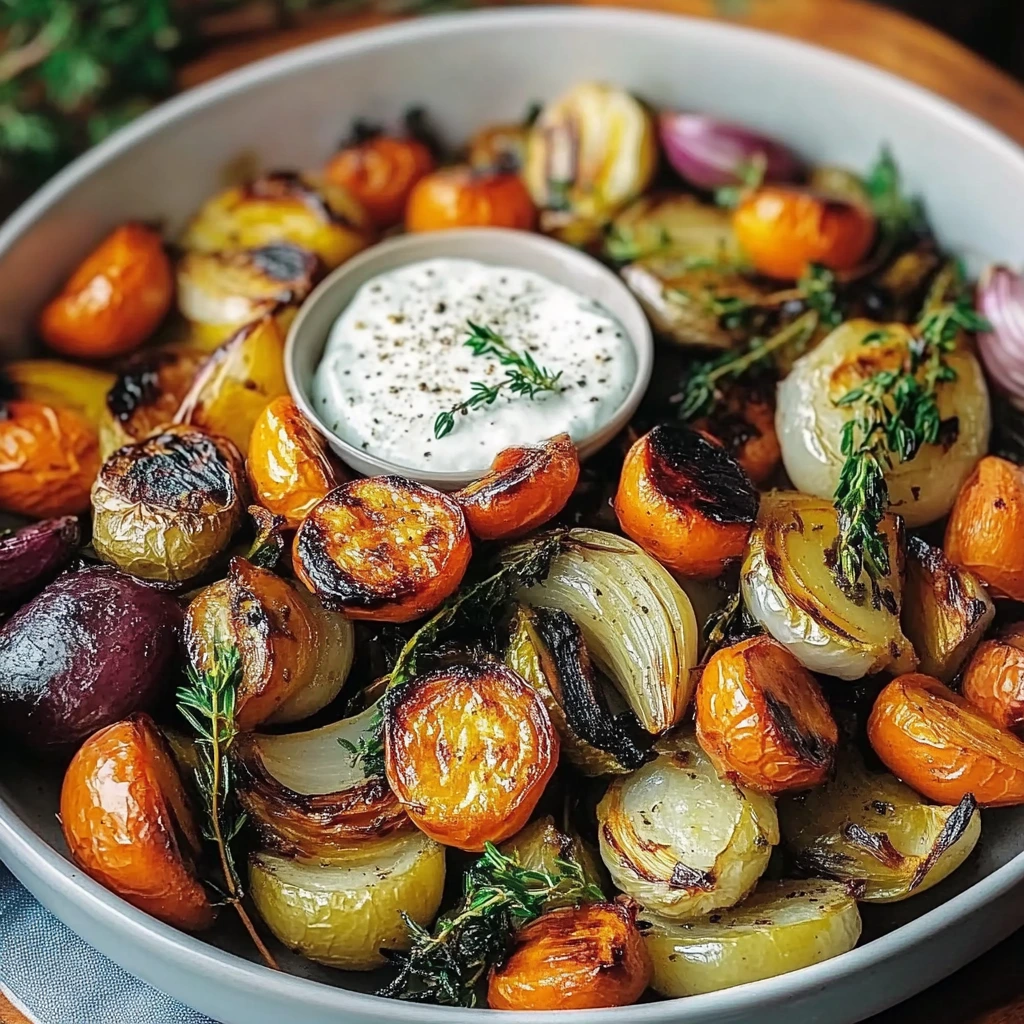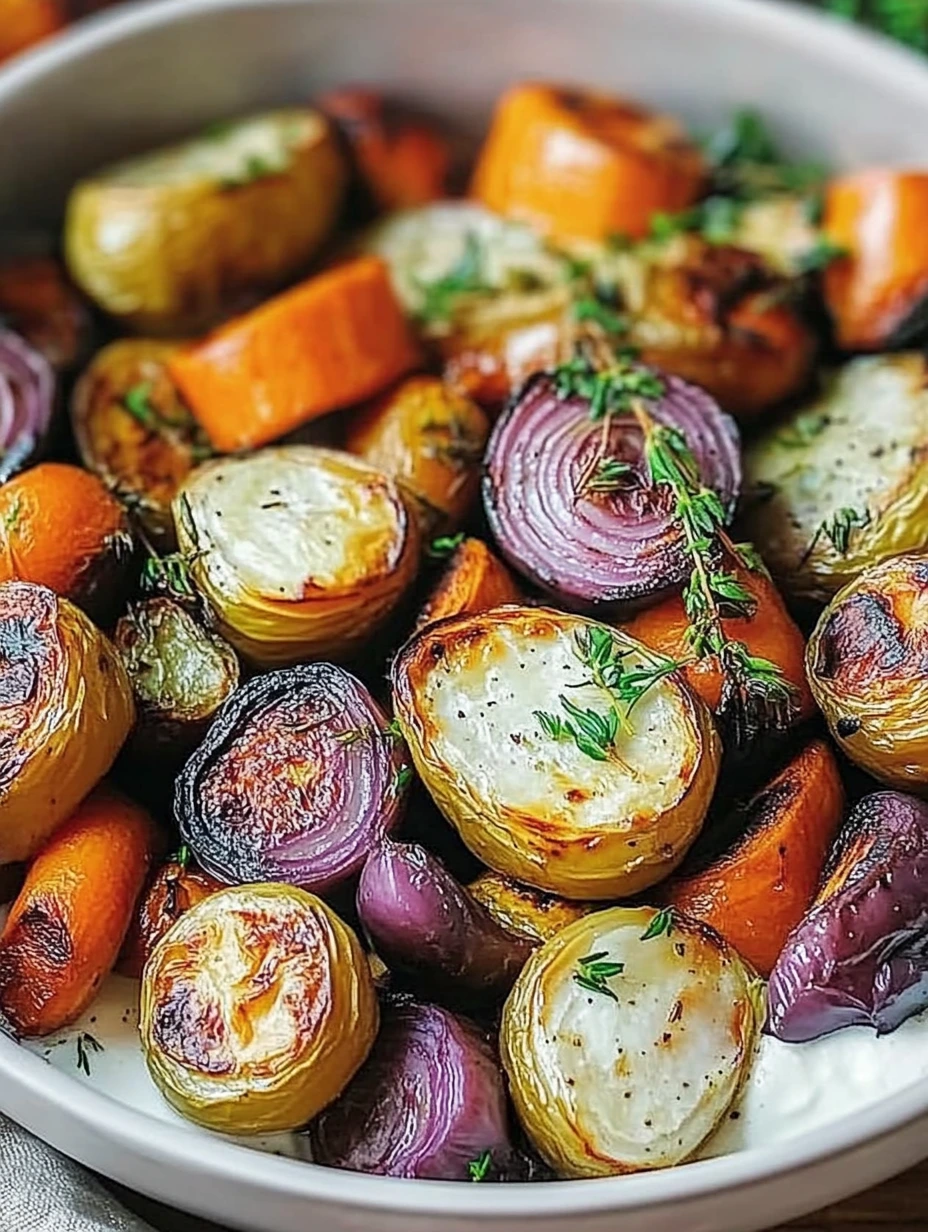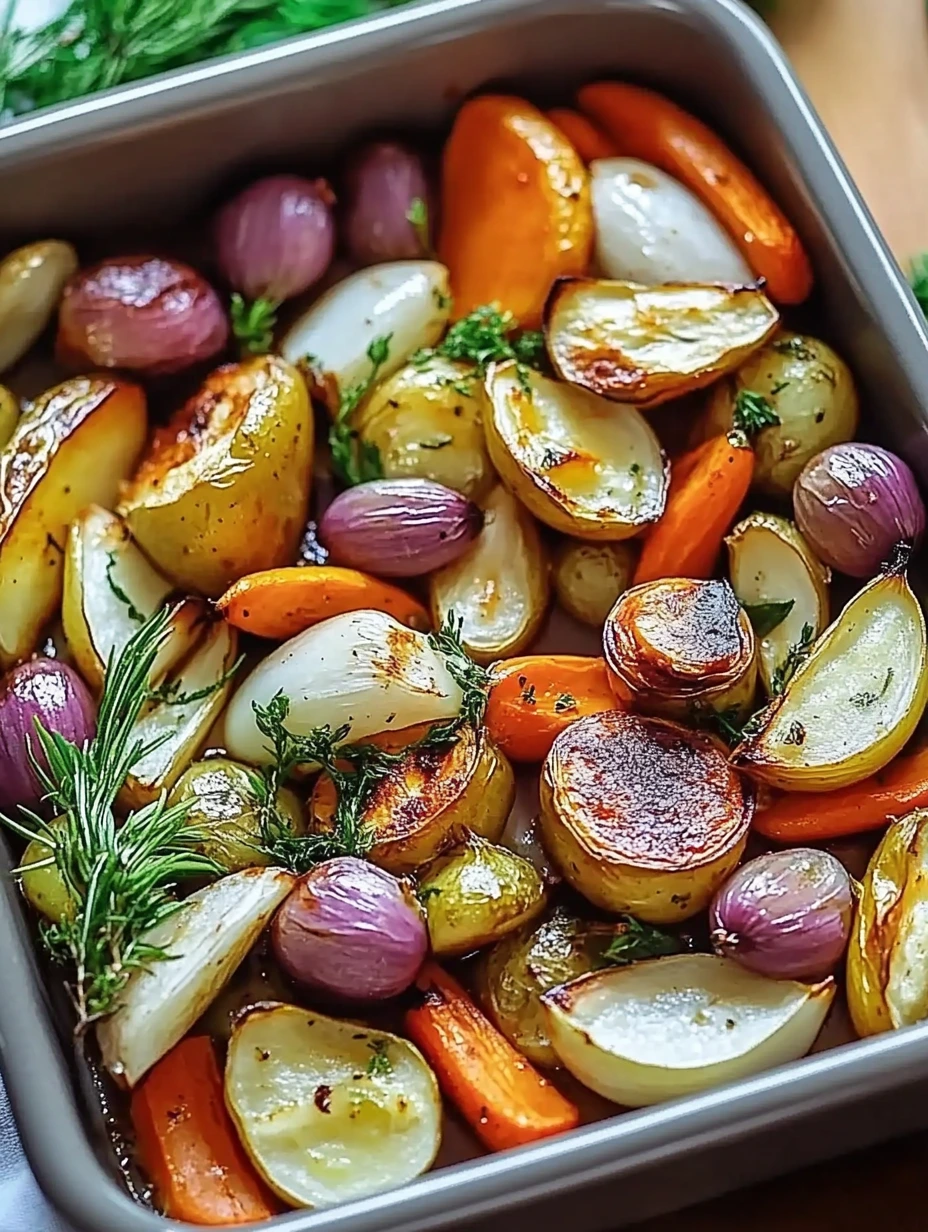 Pin it
Pin it
When root vegetables gently brown in the oven, they unlock their natural sweetness while fragrant herbs add amazing scents to the mix. This dish makes the most of what cold weather offers, turning simple country ingredients into a colorful feast that warms you inside and out. It's an easy way to turn everyday veggies into something really special.
I came up with this during an extra cold winter when the market was packed with root veggies. I wanted to highlight their deep flavors without changing them too much, so I worked out this cooking method that quickly became a winter staple in my kitchen. My mother-in-law, who isn't big on trying new foods, now always asks me to make this when she comes over for dinner.
Garden Gems
- Sweet potato: pick ones that feel heavy for their size with smooth, shiny skin
- Carrots: go for young, firm ones with bright color which means they'll taste sweeter
- Parsnips: choose medium-sized ones since they pack more flavor than the really big ones
- Brussels sprouts: look for small, tight ones for a milder taste with less bitterness
Chef's Walkthrough
- Careful prep work:
- Start by washing all your veggies under cold water to get rid of any dirt. Peel them gently to keep as much of the outer layers as you can since that's where many nutrients live. Then cut everything to the same size so they'll cook evenly. Cut root veggies into 1-inch chunks and just halve the Brussels sprouts to show off their inner leaves.
- Flavor matching:
- Spread your prepped veggies on a big baking sheet without overcrowding them so they can brown nicely. Drizzle plenty of good olive oil and sprinkle fresh herbs like rosemary and thyme. Add a good amount of salt and freshly ground pepper. Use your hands to gently toss everything so each piece gets coated with the seasoned oil.
- Cooking magic:
- Heat your oven to 400°F to get the perfect browning conditions. Put your tray in the middle of the oven and let the magic happen for about 20 minutes before carefully flipping the veggies for even browning. Keep cooking another 15-20 minutes, watching for tenderness and color. You want crispy, golden edges with soft, melty centers.
- Tasty finishing touch:
- While your veggies roast, make a creamy Greek yogurt sauce. In a bowl, mix drained yogurt with finely chopped herbs, some fresh lemon zest and juice, a bit of crushed garlic, and plenty of seasoning. This cool, creamy sauce will taste amazing with the caramelized veggies, adding freshness and smoothness.
I love making this on winter Sundays when everyone's home together. The warm oven heats up the house while the smell of veggies and herbs makes everything feel cozy and welcoming. My son, who usually turns his nose up at vegetables, fell for the sweetness of the caramelized sweet potato and now always cleans his plate happily.
 Pin it
Pin it
Tasty Pairings
These roasted veggies go wonderfully with a roast chicken whose juices add even more flavor. For a complete vegetarian meal, serve them with a generous drizzle of tahini and some toasted seeds. They also make a perfect side for mild white fish like cod or haddock. For a festive touch, toss in some chopped nuts and dried cranberries during the last few minutes of cooking.
Creative Twists
In late fall, swap in some butternut or acorn squash cubes for extra sweetness. During the coldest months, try adding Jerusalem artichokes and salsify for a more adventurous flavor exploration. For a Mediterranean version, include artichoke quarters and fennel flavored with garlic and lemon. Spice lovers will enjoy adding some ginger root and a sprinkle of chili flakes.
Second Life
These roasted veggies keep well for up to three days in an airtight container in the fridge. Warm them up in the oven to keep their texture but avoid the microwave which makes them soggy. They make a great base for nutritious buddha bowls the next day with some quinoa and tahini sauce. You can also turn them into a creamy soup by blending them with some broth and a bit of cream.
For a different brunch option, roughly mash these cooled veggies and mix them with beaten eggs to make a colorful, tasty frittata. They can also fill a crustless quiche for a light but filling lunch.
What makes this dish so great is also its amazing nutritional value. Every bite gives you powerful antioxidants from the colorful veggies and important fiber from the root vegetables. The olive oil adds healthy fats while fresh herbs help digestion with their natural enzymes. It's a comforting dish that truly nourishes both body and mind.
Perfect Sauces
Try different sauce traditions to go with these veggies. A Middle Eastern version with za'atar and sumac brings an amazing tangy, herby flavor. For a Nordic twist, mix dill and horseradish into your Greek yogurt for an intense freshness. Heat lovers will enjoy adding mild harissa balanced with cooling mint.
Special Moments
This generous dish fits naturally into family Sunday meals, where its colorful look brightens the table and makes everyone happy. It's also great for buffets since it can be served at room temperature without losing its taste quality. For a more formal dinner, serve these veggies on a preheated large serving dish, topped with fresh herbs and their creamy sauce on the side.
Smart Storage
If you somehow have leftovers, keep them for up to three days in an airtight container in the fridge. They're perfect for creating new creative dishes. Turn them into a smooth velvety soup by blending them with some broth and a touch of cream. Mix them cold into grain salads like spelt or quinoa for a complete, balanced lunch. Use them as tasty filling for a quick quiche or savory tart.
These roasted veggies are so versatile they're a major asset in your winter cooking toolkit. Their flavor, developed through caramelization, lets you quickly create tasty side dishes with minimal effort. I particularly love how they can turn a simple poached egg into a fancy lunch or upgrade next day's sandwich.
 Pin it
Pin it
Technical Tips
- Use thick metal baking sheets for the best heat distribution
- Never stack or crowd your veggies if you want them to brown properly
- A splash of quality olive oil just before serving boosts the flavors
- Deglazing the pan with a bit of white wine or broth creates a tasty natural sauce
The magic works differently as winter changes. Early in the season, focus on the sweetness of the first sweet potatoes and new carrots. In midwinter, explore the earthier, more complex flavors of parsnips, Jerusalem artichokes, and rutabagas. As spring approaches, gradually add in the first baby turnips and radishes for a gentle shift toward springtime cooking.
Finishing Touches
- Serve on a warmed platter to keep everything at the right temperature longer
- Save some fresh herbs to sprinkle just before serving
- Good crusty bread helps you enjoy all the caramelized juices
- A glass of dry white wine with mineral notes completes the meal perfectly
This winter roasted veggie dish shows that seasonal cooking can be simple, comforting, and sophisticated all at once. It reminds us that every season, even the coldest one, offers food treasures worth celebrating and fully enjoying. The simplicity contains a real cooking lesson: respect the ingredient, understand what makes it special, and enhance it without changing its true nature.
Frequently Asked Questions
- → Can I prep the veggies ahead of time?
- Sure, chop the veggies the day before and store them in the fridge. Reheat at 180°C for 10–15 minutes before serving.
- → How can I make this vegan?
- Swap the Greek yogurt for soy or coconut yogurt, and replace the cream with a plant-based one like oat or soy cream.
- → Can I swap the vegetables?
- Definitely! Feel free to include seasonal options like pumpkin, beets, celery root, or turnips.
- → Can I make the yogurt dressing in advance?
- Yes, you can. It’ll stay fresh in the fridge for up to 3 days in a sealed container. Give it a stir before using.
- → What’s a good pairing for a full meal?
- Serve the veggies with quinoa, bulgur, or brown rice for a well-balanced vegetarian plate.
